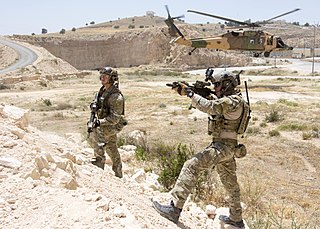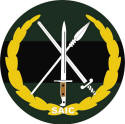
Special operations or special ops are military activities conducted, according to NATO, by "specially designated, organized, selected, trained, and equipped forces using unconventional techniques and modes of employment." Special operations may include reconnaissance, unconventional warfare, and counterterrorism, and are typically conducted by small groups of highly trained personnel, emphasizing sufficiency, stealth, speed, and tactical coordination, commonly known as special forces.

The South African Army is the principal land warfare force of South Africa, a part of the South African National Defence Force (SANDF), along with the South African Air Force, South African Navy and South African Military Health Service. The Army is commanded by the Chief of the Army, who is subordinate to the Chief of the SANDF.

The South African Special Forces Brigade, colloquially known as the Recces, is South Africa's principal tier one special forces, specialising in various types of operations, including air assault and airborne operations, amphibious warfare, clandestine and covert operations, counterterrorism, direct action, executive protection, force protection, foreign internal defense, hostage rescue, irregular warfare, long-range penetration, ISTAR, special reconnaissance, special warfare, underwater demolition, and VBSS. The brigade operates with two active-duty groups, with 4 Special Forces Regiment focusing on maritime operations, and 5 Special Forces Regiment focusing on land and airborne operations. Only about 8% of recruits who undergo South African special forces training pass the course.

The South African Defence Force (SADF) comprised the armed forces of South Africa from 1957 until 1994. Shortly before the state reconstituted itself as a republic in 1961, the former Union Defence Force was officially succeeded by the SADF, which was established by the Defence Act of 1957. The SADF, in turn, was superseded by the South African National Defence Force in 1994.
Jan Dirk Breytenbach was a South African Special Forces military officer and author of military books. He is best known as the first commander of 1 Reconnaissance Commando, South Africa's first special forces unit. In his long career, he served in the Suez Crisis, the Biafran War, the South African Border War, and the Angolan Civil War, and attained the rank of colonel before his retirement. He died on 16 June 2024, at the age of 91.

The South West Africa Territorial Force (SWATF) was an auxiliary arm of the South African Defence Force (SADF) and comprised the armed forces of South West Africa from 1977 to 1989. It emerged as a product of South Africa's political control of the territory which was granted to the former as a League of Nations mandate following World War I.

The South African Army Infantry Formation supervises all infantry within the South African Army.

South Africa currently does not have a marine corps, though in the past it did. It was originally set up as a sub-branch of the South African Navy during the apartheid era, with the primary purpose of protecting the country's harbours (1951-1955). Then it was recreated in 1979 during the South African Border War as 1 Marine Brigade with the aim of serving as marine infantry (1979-1990). Today, the SAN Maritime Reaction Squadron is the closest analogue to a marine corps South Africa has.

44 Parachute Brigade was a parachute infantry brigade of the South African Army. It was founded on 20 April 1978, by Colonel Jan Breytenbach, following the disbandment of 1 SA Corps and the battle of Cassinga. Upon formation, the brigade was commanded by Brigadier M. J. du Plessis, who was assigned the task of establishing by working with the Parachute Staff Officer, Colonel Jan Breytenbach. At the time du Plessis was the commanding officer of the Orange Free State Command and had previous experience serving in 1 Parachute Battalion. Breytenbach had also been a member of 1 Parachute Battalion and had also founded the South African Special Forces Brigade and 32 Battalion. The location that was chosen for the brigade's headquarters was in the lines of the OFS Cmd Headquarters, next to the old Tempe Airfield in Bloemfontein.

1 Parachute Battalion is the only full-time paratroop unit of the South African Army. It was founded on 1 April 1961, along with the Parachute Battalion. The name of this unit was changed to Parachute Training Centre after 1998. It was the first battalion within 44 Parachute Brigade until 1999 when the brigade was downsized to 44 Parachute Regiment

The 44 Pathfinder Platoon is part of the 44 Parachute Regiment. The pathfinder is a trained and specialized paratrooper, who performs covertly behind enemy lines, either in small groups or in collaboration with other reconnaissance units.
Operation Firewood was a secretive military operation in 1987 by the South African Defence Force (SADF) during the South African Border War.
Operation Beanbag, also known as the Matola Raid, was a military operation conducted by the South African Defence Force (SADF) against suspected safe houses of uMkhonto we Sizwe (MK), armed wing of the African National Congress (ANC), in Matola, Mozambique.

The Honoris Crux of 1975, post-nominal letters HC, is a military decoration for bravery which was instituted by the Republic of South Africa on 1 July 1975. The decoration was awarded to members of the South African Defence Force for bravery in dangerous circumstances. It was the junior in a set of four Honoris Crux decorations in four classes, which together replaced the discontinued Honoris Crux of 1952.

Natal Command was a Command of the South African Army. It was headquartered in Durban, South Africa. By the 1980s, it was responsible for the security of the region, forming the primary level of command for military operations in support of the Police. It also provided logistic, administrative and service support to units and formations operating in its area of responsibility.
2 Reconnaissance Regiment was the Active Citizen Force unit of the South African Special Forces. Its part-time service personnel formed part of the reserve component of the South African Defence Force.
The 3 Reconnaissance Commando was a South African special forces unit.
The 4 Reconnaissance Commando was a one of six commando regiment unit of the South African Army and part of the South African Special Forces (Recces) that was formed in July 1978, specialising in air assault and airborne operations, amphibious warfare, combat diving, combat patrols, commando style raids, irregular warfare, long-range penetration, and special reconnaissance. It was the only commando regiment unit of the South African Army responsible for amphibious warfare operations and combat diving.
The Namibian Special Forces is a special operations command of the Namibian Defence Force responsible for special forces component commands army and marines. The command consists of Namibian Army Commando and Paratrooper, and the Namibian Marine Corps Amphibious Special Operations Unit. The Army Commando specialize in air assault and airborne operations, capture or kill high-value targets, counterterrorism, direct action, hostage rescue, insertion behind enemy lines, executive protection, and special warfare operations, while the Marine Corps Amphibious Special Operations Unit specialize in amphibious warfare, direct action, executive protection, insertion behind enemy lines, maritime counterterrorism and hostage rescue, naval boarding, naval special warfare operations, operating that originate from a river, ocean, swamp and delta, and underwater demolition. The army units receive training assistance from former South African Special Forces (Recces) and the marine corps from the Brazilian Marine Corps. The units regularly participate in Southern African Development Community (SADC) special forces exercises.










